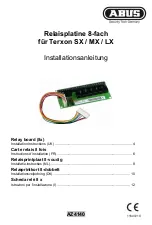
7800 SERIES EC7890A,B/RM7890A,B RELAY MODULE
65-0204–1
25
setpoint of the operating controller or setting the Fuel Selector
Switch to OFF. Do not open the master switch. Visually
observe when the burner flame goes out. If the FLAME LED
is on longer than .8 or 3 seconds (depending on the FFRT of
the amplifier), the photocell is sensing hot refractory. This
condition must be corrected as described in the last
paragraph of this test.
Infrared (lead sulfide) detectors can respond to infrared rays
emitted by a hot refractory, even when the refractory has visibly
ceased to glow. Infrared radiation from a hot refractory is
steady, but radiation from a flame has a flickering
characteristic. The infrared detection system responds only to
flickering infrared radiation; it can reject a steady signal from
hot refractory. The refractory steady signal can be made to
fluctuate if it is reflected, bent or blocked by smoke or fuel mist
within the combustion chamber. Be careful when applying an
infrared system to verify its response to flame only.
To check infrared (lead sulfide) detectors for hot refractory
hold-in, operate the burner until the refractory reaches its
maximum temperature. If the installation has a multi-fuel
burner, burn the heaviest fuel that is most likely to reflect,
bend or obscure the hot refractory steady infrared radiation.
When the maximum refractory temperature is reached, close
all manual fuel shutoff valve(s) or open the electrical circuits
of all automatic fuel valve(s). Visually observe when the
burner flame or FLAME LED goes out. If this takes longer
than three seconds, the infrared detector is sensing hot
refractory. Immediately terminate the firing cycle. Lower the
setpoint to the operating controller, or set the Fuel Selector
Switch to OFF. Do not open the master switch.
NOTE:
Some burners continue to purge oil lines between
the valve(s) and nozzle(s) even though the fuel
valve(s) is closed. Terminating the firing cycle
(instead of opening the master switch) will allow
purging of the combustion chamber. This will reduce
a buildup of fuel vapors in the combustion chamber
caused by oil line purging.
If the detector is sensing hot refractory, the condition must be
corrected. Add an orifice plate in front of the cell to restrict the
viewing area of the detector. If this does not correct the
problem, resight the detector at a cooler, more distant part of
the combustion chamber. While resighting the detector, be
aware that it must also properly sight the flame. When using
an infrared detector, try lengthening the sight pipe or
decreasing the pipe size (diameter). For details, refer to the
detector Instructions and the equipment Operating Manual.
Continue adjustments until hot refractory hold-in is eliminated.
Ultraviolet Sensor, Ignition Spark Response
Test (All Ultraviolet Detectors)
Test to be sure that the ignition spark is not actuating the
FLAME LED:
1
Close the pilot and main burner manual fuel shutoff
valve(s).
2
Start the burner and run through the PILOT IGN period.
Ignition spark should occur, but the flame signal should
not be more than 0.5 Vdc and the FLAME LED should
not turn on.
3
If the flame signal is higher than 0.5 Vdc and the
FLAME LED does come on, consult the equipment
Operating Manual and resight the detector further out
from the spark or away from possible reflection. It may
be necessary to construct a barrier to block the ignition
spark from the detector view. Continue adjustments
until the flame signal due to ignition spark is less than
0.5 Vdc.
NOTE:
The Honeywell Q624A Solid State Spark
Generator will prevent detection of ignition
spark when properly applied with the C7027,
C7035 or C7044 Minipeeper Ultraviolet
Flame Detectors. The Q624A is only for use
with gas pilots.
Response to Other Ultraviolet Sources
Under certain conditions, an ultraviolet detector will respond
to other ultraviolet sources as if it is sensing a flame. These
ultraviolet sources include artificial light, such as
incandescent or fluorescent bulbs, mercury and sodium vapor
lamps or daylight. To check for proper detector operation,
check the Flame Failure Response Time (FFRT) and conduct
Safety Shutdown tests under all operating conditions.
Flame Signal with Hot Combustion Chamber
(All Installations)
After all initial start-up tests and burner adjustments are
completed, operate the burner until the combustion chamber
is at the maximum expected temperature. Observe the
equipment manufacturer warmup instructions. Recycle the
burner under these hot conditions and measure the flame
signal. Check the pilot alone for non-DSI applications or the
main burner flame for DSI applications.
Check the FFRT of the Flame Amplifier. Lower the setpoint of
the operating controller and observe the time it takes for the
burner flame to go out. This should be within .8 or 3 seconds
maximum, depending on the amplifier selected.
If the flame signal is too low or unsteady, check the flame
detector temperature. Relocate the detector if the
temperature is too high. If necessary, realign the sighting to
obtain the proper signal and response time. If the response
time is still too slow, replace the Plug-in Flame Signal
Amplifier. If the detector is relocated or resighted or the
amplifier is replaced, repeat all required Checkout tests.
Safety Shutdown Tests (All Installations)
Perform these tests at the end of Checkout after all other
tests have been completed. If used, the external alarm should
turn on. Press the 7890 reset pushbutton to restart the
system.
1
Detect flame 40 seconds after entry to STANDBY.
a.
Simulate a flame to cause the flame signal voltage
level to be at least 1.25 Vdc for 30 seconds after
the initial 40 second entry into STANDBY.
b.
Safety shutdown will occur.




































